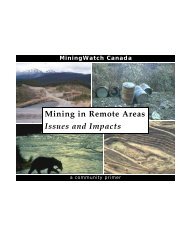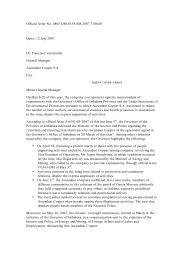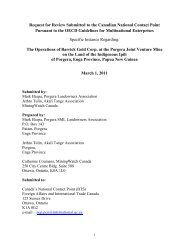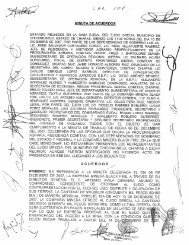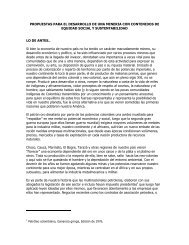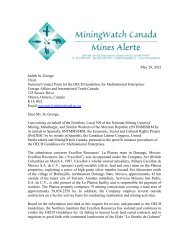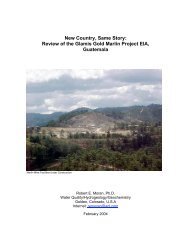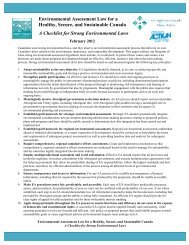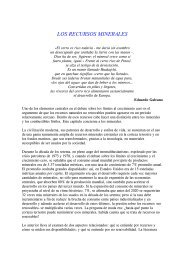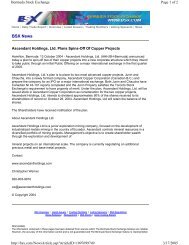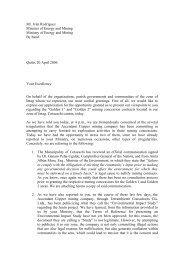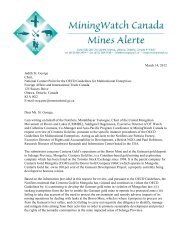Environmental Aspects of Phosphate and Potash Mining
Environmental Aspects of Phosphate and Potash Mining
Environmental Aspects of Phosphate and Potash Mining
- No tags were found...
You also want an ePaper? Increase the reach of your titles
YUMPU automatically turns print PDFs into web optimized ePapers that Google loves.
<strong>Environmental</strong> <strong>Aspects</strong> <strong>of</strong> <strong>Phosphate</strong> <strong>and</strong> <strong>Potash</strong> <strong>Mining</strong><strong>Environmental</strong> Financial Sureties: South African <strong>and</strong> Australian CasesIn South Africa, financial provisions for closure havebeen required since 1994. Four types <strong>of</strong> financial suretyare currently permitted: A dedicated trust fund; A cash deposit to an account with the Department <strong>of</strong>Minerals <strong>and</strong> Energy; A guarantee from a financial institution; Other arrangements approved by the DirectorGeneral <strong>of</strong> the Department <strong>of</strong> Minerals <strong>and</strong> Energy.Trust funds are the most common instrument adoptedby larger companies, both because <strong>of</strong> the greater inhousefinancial management resources, <strong>and</strong> the taxadvantages <strong>of</strong>fered. Contributions are spread evenlyover the life <strong>of</strong> mine with the financial liability assessedon an annual basis. Allowances are made for new disturbance<strong>and</strong> rehabilitation activities conducted duringthe period.The financial provision system is currently beingreviewed through ongoing discussion between government<strong>and</strong> industry. Several additional financialsurety methods are being proposed, such as parentcompany guarantees <strong>and</strong> the use <strong>of</strong> insurance policies.A means <strong>of</strong> recognizing <strong>and</strong> providing credit for previousgood performance is also proposed.The Phalaborwa operation <strong>of</strong> Foskor Limited has establisheda trust fund to satisfy the environmental financialprovision requirements. The fund is registered with thegovernment, but operated by the company.Contributions to the fund are determined by the quantity<strong>of</strong> production <strong>and</strong> made on a monthly basis, withregular audits conducted by financial advisers. Whenthe company wishes to use some <strong>of</strong> the funds for thepurpose <strong>of</strong> rehabilitation, a proposal must be submittedfor government approval.In Australia, WMC Resources Ltd. owns <strong>and</strong> operates the<strong>Phosphate</strong> Hill phosphate rock operation in the State <strong>of</strong>Queensl<strong>and</strong>.The state government requires the lodging<strong>of</strong> financial assurances to guarantee conduct <strong>of</strong> therehabilitation plan as outlined in the <strong>Environmental</strong>Management Overview Strategy (EMOS), prepared inaccordance with regulatory requirements. The amountis based on the maximum cost <strong>of</strong> rehabilitating the netdisturbance <strong>of</strong> the lease during the life <strong>of</strong> the currentplan <strong>of</strong> operations, reduced by a discount for past goodenvironmental performance. This discount can varyfrom 15 to 75%, creating an incentive for good performanceby companies demonstrating their environmentalcredentials through past behavior.Closure <strong>of</strong> the Mines de Potasse d'Alsace (MDPA) OperationsFigure 3.7.1Waste piles dissolution schematic. MDPA, France.Depollution wellRainAccelerated dissolving processSprinklers or monitorsGroundwaterPercolationRun-<strong>of</strong>fTowardsRhineTrenchcollectLateralresurgencesTowardsRhineImpervious basementDepollution wellMines de Potasse d'Alsace (MDPA) currently operatesthe Amelie underground potash mine <strong>and</strong> processingplant <strong>and</strong> the Marie-Louise underground mine nearMulhouse in northeast France.<strong>Mining</strong> <strong>of</strong> the potash orebodies in the region began in1910. The workforce peaked in 1965 at around 14,000<strong>and</strong> dropped to 1,300 by mid 2000. The number <strong>of</strong>operating mines <strong>and</strong> plants has fallen similarly, <strong>and</strong> atpresent two mines <strong>and</strong> one plant are in operation. Theore deposit is approaching exhaustion, with completion<strong>of</strong> mining anticipated by 2003. Planning <strong>and</strong>preparation for this eventuality began a number <strong>of</strong>years back.The long potash mining history <strong>of</strong> the region has left alegacy <strong>of</strong> challenges. Closure planning <strong>and</strong> preparationhas focused on:Water production wellImpervious basementDepollution well Rehabilitation <strong>of</strong> the surface waste piles (referred toas terrils); Remediation <strong>of</strong> the salt-contaminated surfaceaquifer; Removal <strong>of</strong> decommissioned plant, equipment <strong>and</strong>materials; Creation <strong>of</strong> alternative employment for the workforce<strong>and</strong> community.The major environmental issue revolves around thewaste piles dumped adjacent to the beneficiationplants prior to 1934. These were placed without linersor other containment features. Subsequent dissolution<strong>of</strong> the salt by rain has contaminated theunderlying aquifer giving rise to plumes <strong>of</strong> salt contaminationdown flow from the piles. Rehabilitationactivities have focused on both removing the source



